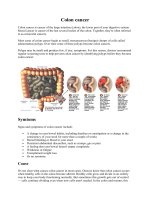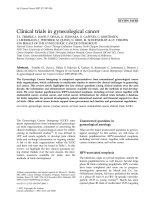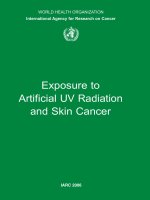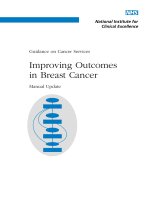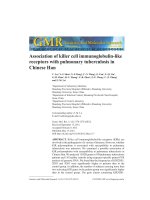HIGHLIGHTS IN SKIN CANCER pdf
Bạn đang xem bản rút gọn của tài liệu. Xem và tải ngay bản đầy đủ của tài liệu tại đây (10.88 MB, 308 trang )
HIGHLIGHTS IN SKIN
CANCER
Edited by Pierre Vereecken
Highlights in Skin Cancer
/>Edited by Pierre Vereecken
Contributors
Rohinton S Tarapore, Burhan Engin, Laurence Coiffard, Marian Dmochowski, Justyna Gornowicz-Porowska, Paweł
Pietkiewicz, Monika Bowszyc-Dmochowska, Lisa Passantino, Max Costa, Mary Matsui, Cintia Andrade, Natalia Inada,
Dora Ramirez, Vanderlei Bagnato, Cristina Kurachi, Pierre Vereecken, Carolyn Heckman, Susan Darlow, Teja Munshi,
Clifford Perlis, Małgorzata Juszko-Piekut, Terrence Jerald Piva, Rethika Ravi
Published by InTech
Janeza Trdine 9, 51000 Rijeka, Croatia
Copyright © 2013 InTech
All chapters are Open Access distributed under the Creative Commons Attribution 3.0 license, which allows users to
download, copy and build upon published articles even for commercial purposes, as long as the author and publisher
are properly credited, which ensures maximum dissemination and a wider impact of our publications. However, users
who aim to disseminate and distribute copies of this book as a whole must not seek monetary compensation for such
service (excluded InTech representatives and agreed collaborations). After this work has been published by InTech,
authors have the right to republish it, in whole or part, in any publication of which they are the author, and to make
other personal use of the work. Any republication, referencing or personal use of the work must explicitly identify the
original source.
Notice
Statements and opinions expressed in the chapters are these of the individual contributors and not necessarily those
of the editors or publisher. No responsibility is accepted for the accuracy of information contained in the published
chapters. The publisher assumes no responsibility for any damage or injury to persons or property arising out of the
use of any materials, instructions, methods or ideas contained in the book.
Publishing Process Manager Danijela Duric
Technical Editor InTech DTP team
Cover InTech Design team
First published April, 2013
Printed in Croatia
A free online edition of this book is available at www.intechopen.com
Additional hard copies can be obtained from
Highlights in Skin Cancer, Edited by Pierre Vereecken
p. cm.
ISBN 978-953-51-1073-6
free online editions of InTech
Books and Journals can be found at
www.intechopen.com
Contents
Preface VII
Chapter 1 Incidence of Melanoma and Non-Melanoma Skin Cancer in the
Inhabitants of the Upper Silesia, Poland 1
Małgorzata Juszko-Piekut, Aleksandra Moździerz, Zofia Kołosza,
Magdalena Królikowska-Jerużalska, Paulina Wawro-Bielecka,
Grażyna Kowalska-Ziomek, Dorota Olczyk and Jerzy Stojko
Chapter 2 Serum Markers in Clinical Management of Malignant
Melanoma 27
Pierre Vereecken
Chapter 3 An Overview of Important Genetic Aspects in Melanoma 43
Rohinton S. Tarapore
Chapter 4 Current Management of Malignant Melanoma: State
of the Art 67
Zekayi Kutlubay, Burhan Engin, Server Serdaroğlu and Yalçın Tüzün
Chapter 5 About Suncare Products 127
C. Couteau and L. Coiffard
Chapter 6 Malignancy in Relation to Autoimmune Blistering Dermatoses:
Molecular and Clinical Aspects 159
Paweł Pietkiewicz, Justyna Gornowicz-Porowska, Monika Bowszyc-
Dmochowska and Marian Dmochowski
Chapter 7 Skin Cancer Prevention Strategies 211
Lisa Passantino, Max Costa and Mary Matsui
Chapter 8 Photodynamic Therapy for Non-Melanoma Skin Cancer 233
Cintia Teles de Andrade, Natalia Mayumi Inada, Dora Patricia
Ramirez, Vanderlei Salvador Bagnato and Cristina Kurachi
Chapter 9 Skin Cancer Screening 249
Carolyn J. Heckman, Susan Darlow, Teja Munshi and Clifford Perlis
Chapter 10 The Role of Furin in the Development of Skin Cancer 271
Rethika Ravi and Terrence J Piva
ContentsVI
Preface
Since the middle of the 20th century, the incidence of skin cancers such as malignant mela‐
noma is increasing most in the Caucasian population, doubling every 10 years to reach the
current rate of 10-15 new cases per year per 100,000 inhabitants. Epidemiological models
suggest that prediction is that now a person out of 75 is likely to develop a melanoma in his
lifetime. Cutaneous carcinomas are also more frequent.
Along with the increased incidence, increased mortality secondary to melanoma was ob‐
served in the second half of the twentieth century, followed by a stabilization probably related
to efforts in primary and secondary prevention. Therapeutic advances in this area have been
quite limited until recently , despite the enthusiasm generated by clinical trials of immuno‐
therapy, and encourage further efforts to organize prevention and screening compaigns.
Prevention and detection of skin cancer and melanoma in particular are important public
health goals in order to decrease the impact of these frequent tumours in young patients.
These objectives require particularly strong solidarity between GPs and dermatologists, both
in firstline for the evaluation of the skin of patients and to detect their risk factors.
Despite the fact that new recent progress in skincancer treatment have been described, and
that new targeted molecules or new therapeutic procedures help our patients, new insights
regarding skin biology are also needed to develop new strategies. Moreover interactions be‐
tween dermatologists and oncologists are mandatory: many targeted therapies developed to
treat systemic malignancies have shown important efficacy for the treatment of both cutane‐
ous malignancies and non-malignant skin disease, such as Hedgehog inhibition for basal
cell carcinoma and Rituximab for Pemphigus Vulgaris.
This Highlights in Skincancer written by leading experts in their field synthesize common
skincancer topics in clinics and research. It is not a guide intended to be a comprehensive
and exhaustive review of all the aspects of dermato-oncology but really a companion that
should help the clinicians and researchers to find important and specialized information in
this field. It is also an awareness of the close collaboration that must exist between dermatol‐
ogists and medical oncologists in the management of our patients.
Pierre Vereecken, MD, PhD
Cliderm, European Institute for Dermatology Practice and Research,
Chirec Cancer Institute, Brussels, Belgium
Chapter 1
Incidence of Melanoma
and Non-Melanoma Skin Cancer in the
Inhabitants of the Upper Silesia, Poland
Małgorzata Juszko-Piekut, Aleksandra Moździerz,
Zofia Kołosza, Magdalena Królikowska-Jerużalska,
Paulina Wawro-Bielecka,
Grażyna Kowalska-Ziomek, Dorota Olczyk and
Jerzy Stojko
Additional information is available at the end of the chapter
/>1. Introduction
In recent years, non-melanoma incidence rate has been ranked in the 4
th
place, and
cutaneous melanoma has not been recorded in the first ten places among the most frequent
cancers in the inhabitants of the Upper Silesia. Despite high incidence rates, the progno‐
ses of the skin cancers are good, thus the cancer mortality is ranked lower than in the first
ten places [1-3]. The authors of the study have already presented epidemiological analy‐
ses of the incidence of those cancers [4-7]. Thus the aim of the present study was to
continue the evaluation of the incidence rates of non-melanoma skin cancers in the
inhabitants of the Upper Silesia in 1999-2007.
The Upper Silesia Industrial Area, occupying the central part of Silesia, has been the most
industrial and most ecologically degraded area of Poland. Called the Silesia Agglomera‐
tion, it is the biggest urban and industrial agglomeration in the country assembling a
number of big cities and industrial areas surrounding them. This affects the landscape and
living conditions of habitants. Here, the main source of pollution is the industry, especial‐
ly mining and energy industries. Heavy industry, underdeveloped as well as underinvest‐
ed, emits enormous amount of the particulate matter and gases into the atmosphere [8].
© 2013 Juszko-Piekut et al.; licensee InTech. This is an open access article distributed under the terms of the
Creative Commons Attribution License ( which permits
unrestricted use, distribution, and reproduction in any medium, provided the original work is properly cited.
Moreover, it was the most populated area of Poland where there were 393 inhabitants per
1km
2
.
2. Materials and methods
In a retrospective epidemiological analysis, we evaluated the statistical data of the non-
melanoma skin cancer (C44 according to the 10th revision of ICD) and the cutaneous melanoma
(C43) in the residents of the Upper Silesia, an administrative region established by the Local
Government Reorganization Act of 1998 (effective 1 January 1999). The incidence data were
obtained from the Department of Epidemiology and Silesia Cancer Registry, Maria Sklodow‐
ska-Curie Memorial Cancer Center and Institute of Oncology, Gliwice Branch. The non-
melanoma and melanoma incidence were estimated by calculating both, age-specific and
crude rates, and the standardized incidence rates (per the population of 100 000) with the use
of a direct method and “the world’s population” as a standard [9].
The cumulative risk was also calculated. The cumulative risk is the risk which an individual
would have of developing the skin non-melanoma and melanoma from birth to age74 years
if no other causes of death were in operation. Moreover, melanoma and non-melanoma skin
cancer incidence rates were estimated according to the lesion distribution over the body. The
following distribution was included into the study: the head and neck, trunk, arms and legs.
3. Results
Both non-melanoma and melanoma skin cancers belong to the group of cancers typical for the
elderly, which can be also observed in the population of Silesia, a region in Poland (Figure 1).
Incidence rates are of fundamental importance for the evaluation of a skin cancer risk due to
growing effectiveness of treatment, which is related to early diagnosis, and the skin cancer’s
frequent recurrence.
In the Upper Silesia, continuous progression of melanoma as well as non-melanocytic skin
cancers is observed. One in 60 males and one in 80 females runs a risk of developing the skin
cancer till the age of 75 years. During the discussed period, i.e. 1999-2007, 4202 cases of cancer
were recorded in men, and the standardized incidence rate was 14.96/100 000. The average age
of the analyzed male population was 66.7 years, whereas it was 67.8 in the female population.
Incidence rates increased systematically with age in both populations, and an increase in the
rates was quite strong in older age groups. When compared to young males, young females
developed the cancer more frequently, especially those aged 15–39 years. 4389 cases of skin
cancer were recorded in women, and the standardized incidence rate was 10.94/100 000. The
sex ratio was 1.37 for men due to higher incidence rates in men aged 50 years and more, and
the difference increased with age (Table 1), (Figure 2).
Highlights in Skin Cancer
2
0
25
50
75
100
125
150
175
200
225
250
00-04
05-09
10-14
15-19
20-24
25-29
30-34
35-39
40-44
45-49
50-54
55-59
60-64
65-69
70-74
75-79
80-84
85
Males - C44 Males - C43
Females - C44 Females - C43
Figure 1. Age-specific incidence rates for non-melanoma cancer (C44) and melanoma (C43) of the skin by sex, Upper
Silesia, 1999–2007.
Males
Females
Age (years) N Rate N Rate
0-4 0 0.00 0 0.00
5- 9 1 0.09 0 0.00
10-14 1 0.07 1 0.07
15-19 4 0.23 4 0.24
20-24 3 0.17 11 0.63
25-29 14 0.86 20 1.24
30-34 28 1.92 33 2.30
35-39 34 2.36 45 3.15
40-44 119 7.28 105 6.36
45-49 157 9.00 213 11.76
50-54 306 19.75 309 18.68
55-59 391 33.73 384 29.90
60-64 540 56.45 487 43.94
65-69 688 83.57 549 53.14
70-74 751 125.56 685 77.43
Incidence of Melanoma and Non-Melanoma Skin Cancer in the Inhabitants of the Upper Silesia, Poland
/>3
Males Females
Age (years) N Rate N Rate
75-79 650 185.56 721 106.04
80-84 342 223.51 476 122.62
85+ 173 204.64 346 129.19
N 4202 4389
Crude rate 20.39 19.97
ASR 14.96 10.94
Cumulative 0.02% 0.01%
Median age
Mean age
Sex ratio
N – number of cases
Crude rate – cases per 100 000
ASR – age standardized rate (World Standard Population)
Cumulative – cumulative risk (0-74 years)
Table 1. Age-specific, crude and age-standardized incidence rates of non-melanoma skin cancer (C44) among men
and women in Upper Silesia, 1999-2007.
0
25
50
75
100
125
150
175
200
225
250
00-04
05-09
10-14
15-19
20-24
25-29
30-34
35-39
40-44
45-49
50-54
55-59
60-64
65-69
70-74
75-79
80-84
85
Males Females
Figure 2. Age-specific incidence rates for non-melanoma skin cancer in males and females, Upper Silesia, 1999–2007.
Highlights in Skin Cancer
4
Cutaneous melanoma is significantly less frequent in comparison with non-melanoma skin
cancers, and the same is observed in Silesia. In this area, recorded malignant melanoma
incidence rates are approximately 4 times lower in men and 3 times lower in women than non-
melanoma incidence rates (Table 1, 2), (Figure 1). During the period of our studies, there were
1072 cases of cutaneous melanoma diagnosed in men, and 1282 in women. An average age of
the analyzed males was 57.3 years, whereas it was 55.5 in women, thus the age was lower than
in the case of non-melanoma cancer patients. The standardized incidence rates for the Silesian
population were 3.88/10
5
and 4.02/10
5
for males and females, respectively. Sex ratio was 0.96
for females, thus women run a slightly bigger risk of developing melanoma than men. Young
adult and middle aged females are diagnosed with melanoma more frequently than males.
Correspondingly to nonmelanocytic skin cancers, the cancer growth rate is bigger in men than
in women, however men older than 60 years develop melanoma more frequently, and the
difference increases with aging of the population (Table 2), (Figure 1, 3).
Males
Females
Age (years) N Rate N Rate
0-4 0 0.00 0 0.00
5- 9 1 0.09 0 0.00
10-14 0 0.00 2 0.15
15-19 7 0.41 5 0.30
20-24 16 0.90 29 1.67
25-29 19 1.16 45 2.80
30-34 27 1.85 53 3.69
35-39 45 3.12 61 4.26
40-44 86 5.26 104 6.230
45-49 101 5.79 143 7.89
50-54 150 9.68 172 10.40
55-59 118 10.18 135 10.51
60-64 126 13.17 133 12.00
65-69 137 16.64 130 12.58
70-74 124 20.73 122 13.79
75-79 73 20.84 84 12.35
80-84 31 20.26 41 10.56
85+ 11 13.01 23 8.59
N 1072 1282
Crude rate 5.20 5.83
ASR 3.88 4.02
Cumulative 0.00% 0.00%
Median age
Incidence of Melanoma and Non-Melanoma Skin Cancer in the Inhabitants of the Upper Silesia, Poland
/>5
Males Females
Age (years) N Rate N Rate
Mean age
Sex ratio
N – number of cases
Crude rate – cases per 100 000
ASR – age standardized rate (World Standard Population)
Cumulative – cumulative risk (0-74 years)
Table 2. Age-specific, crude and age-standardized incidence rates of cutaneous melanoma (C43) among men and
women in Upper Silesia, 1999-2007.
0
5
10
15
20
25
00-04
05-09
10-14
15-19
20-24
25-29
30-34
35-39
40-44
45-49
50-54
55-59
60-64
65-69
70-74
75-79
80-84
85
Males Females
Figure 3. Age-specific incidence rates for cutaneous melanoma in males and females, Upper Silesia, 1999–2007.
Cutaneous melanoma affects mainly young adults. Our collected data show that in people
younger than 40 years there are 10.7% of cases of cancer in men and 15.2 % in women. Just to
compare, we can say that for non-melanoma skin cancers the percentage was 2% and 2.6% for
men and women, respectively, whereas the incident cases of all cancers for all those age groups
are 4.1% and 5.6% for men and women, respectively. The results suggest that there are 2
epidemiology reference groups of a melanoma incidence rate for the young and old subgroups,
which corresponds to the observations from other parts of Europe [10-15].
When the incidence rates for non-melanomatous skin cancers were compared in relation to
the part of the patient’s body affected by neoplastic lesions, it was concluded that there were
Highlights in Skin Cancer
6
statistically significant differences between males and females, namely more men developed
cancers in all studied cancer sites. Such results were most evidently observed for arms (sex
ratio M:F 1.86) and trunk (sex ratio M:F 1.71) (Table 3), (Figure 4, 5).
Males Females Sex ratio
N ASR N ASR 95% CI
overall 4202 14.96 4383 10.94 1.37 1.31-1.43
Head & neck (C44.0-4) 3124 11.13 3402 8.43 1.32 1.25-1.39
Lip & eyelid (C44.0-1) 429 1.51 562 1.48
external ear (C44.2) 376 1.34 98 0.24
face (C44.3) 2035 7.26 2517 6.15
Scalp & neck (C44.4) 284 1.01 225 0.56
trunk (C44.5) 432 1.54 327 0.90 1.71 1.47-1.99
arms (C44.6) 185 0.67 142 0.36 1.86 1.47-2.35
legs (C43.7) 187 0.66 227 0.54 1.23 1.01-1.51
unspecified (C44.8-9) 247 0.97 291 0.71
N – number of cases
ASR – age standardized rate (World Standard Population)
Table 3. Site-specific rate ratios of non-melanoma skin cancer (C44) in Upper Silesia, 1999-2007.
0
20
40
60
80
100
120
140
160
180
00-04
05-09
10-14
15-19
20-24
25-29
30-34
35-39
40-44
45-49
50-54
55-59
60-64
65-69
70-74
75-79
80-84
85
Males Head & Neck Females Head & Neck
Figure 4. Incidence rates of non-melanoma skin cancer for head and neck in males and females by 5-year age groups,
Upper Silesia, 1999-2007.
Incidence of Melanoma and Non-Melanoma Skin Cancer in the Inhabitants of the Upper Silesia, Poland
/>7
0
2
4
6
8
10
12
14
16
18
00-04
05-09
10-14
15-19
20-24
25-29
30-34
35-39
40-44
45-49
50-54
55-59
60-64
65-69
70-74
75-79
80-84
85
trunk Males hands Males legs Males
trunk Females hands Females legs Females
Figure 5. Incidence rates of non-melanoma skin cancer in males and females by 5-year age groups and anatomic site
except head and neck, Upper Silesia, 1999-2007.
The majority of the lesions was localized on the head and neck (C44.0-C44.4), i.e. 74% of all
neoplastic lesions in men and 78% in women. Most of the lesions were on the face (C 44.3), i.e.
48% and 57% in men and women, respectively. The standardized incidence rate for this cancer
site (head and neck) was 11.13/100 000 in men and 8.43/100 000 in women. When compared to
female patients, the incidence rates of the skin cancer localized on the head and neck are
growing in males aged over 50 years, and the rates are two times higher in those aged more
than 75 years, whereas among younger generations more lesions were recorded in young
females (Table 3), (Figure 4).
The sites of neoplastic lesions in females were ranked in the following order: trunk (C44.5),
legs (C44.7) and arms (C 44.6), whereas in males they were on the trunk (C44.5), arms (C44.6)
and legs (C44.7). The analysis showed that young females developed skin cancers of such
localizations more frequently than males. Higher incidence rates for males than for females
were recorded for the lesions on the trunk, legs and arms in patients older than 35. A strong
increase was recorded for patients older than 50, and the trend persisted until old age. To sum
up, it can be observed that the incidence rates related to the cancer sites are systematically
increasing with age in both populations (Table 3), (Figure 5).
A specific cancer site of melanoma is sex dependent. In males, the most commonly affected
body part is the trunk (especially neoplastic lesions in elderly men), whereas they are legs in
females, which is also observed in the inhabitants of Silesia (Table 4), (Figure 6, 7). Among all
the cases of melanoma diagnosed in male inhabitants of the Upper Silesia, most of the lesions,
Highlights in Skin Cancer
8
namely 48%, were on the trunk (C43.5). Such neoplastic lesions are equally frequent in women
until they are aged 50 years, but in older patients the female incidence rates decreased, whereas
the male rates increased strongly. In cancer patients aged 65-79 years, the male incidence rates
for the trunk were 4 times higher than the female ones. In older men, the main cancer site is
the trunk.
In females, in 38% of cases, the lower limbs were affected by cancer (C43.7), and a strong
increase in the incidence rate was recorded for women aged 40-79 years. Such cancer site is 3
times more frequent in females than in males. We should emphasize that young females
develop the skin cancer more frequently than young men, and the highest incidence rate for
melanoma on legs were recorded for women aged 65-79 years. What is more, female incidence
rates of melanoma for such a site are higher than male ones until old age. The incidence rate
decreased in both population in the oldest age groups.
Arms are a frequent site of melanoma both in males and females (C43.6). In the group of
patients younger than 70 years, higher incidence rates are recorded for females, whereas in
those older than 70 years the incidence rates are 2 times higher in men than in women. The
incidence rates increased systematically with age in both populations (Table 3, 4), (Figure 6, 7).
Summing up, until 50 years of age the body parts affected by melanomas are ranked in the
following order in women: legs, trunk, arms, head and neck, whereas the order is the trunk,
Males
Females Sex ratio
N ASR N ASR 95% CI
overall 1072 3.88 1282 4.02 0.96 0.89-1.05
Head & neck (C43.0-4) 151 0.54 180 0.52 1.03 0.82-1.29
Lip & eyelid (C43.0-1) 23 0.08 25 0.07
external ear (C43.2) 15 0.05 16 0.05
face (C43.3) 57 0.20 106 0.29
Scalp & neck (C43.4) 56 0.21 33 0.12
trunk (C43.5) 511 1.85 305 1.00 1.85 1.60-2.14
arms (C43.6) 147 0.53 225 0.72 0.74 0.60-0.91
legs (C43.7) 161 0.59 494 1.55 0.38 0.32-0.45
unspecified (C43.8-9) 102 0.37 78 0.23
N – number of cases
ASR – age standardized rate (World Standard Population)
Table 4. Site-specific rate ratios of cutaneous melanoma (C43) in Upper Silesia, 1999-2007.
Incidence of Melanoma and Non-Melanoma Skin Cancer in the Inhabitants of the Upper Silesia, Poland
/>9
legs, arms, head and neck in men. At this age, the risk of developing melanomas in all parts
of the body (except the torso) is higher for women than for men. On the other hand, in patients
0
1
2
3
4
5
6
7
8
9
10
00-04
05-09
10-14
15-19
20-24
25-29
30-34
35-39
40-44
45-49
50-54
55-59
60-64
65-69
70-74
75-79
80-84
85
Head & Neck Males trunk Males
hands Males legs Males
Figure 6. Incidence rates of cutaneous melanoma in males by 5-year age groups and anatomic site, Upper Silesia,
1999-2007.
0
1
2
3
4
5
6
7
8
9
10
00-04
05-09
10-14
15-19
20-24
25-29
30-34
35-39
40-44
45-49
50-54
55-59
60-64
65-69
70-74
75-79
80-84
85
Head & Neck Females trunk Females
hands Females legs Females
Figure 7. Incidence rates of cutaneous melanoma in females by 5-year age groups and anatomic site, Upper Silesia,
1999-2007.
Highlights in Skin Cancer
10
over 50 years of age the rate of melanomas increases with age on legs and decreases for the
trunk in women, but in men the rate increases for the trunk, however melanoma develops
more slowly on legs.
When both types of skin cancers are compared, we can notice that the rates increase system‐
atically with age. The incidence rate of non-melanoma skin cancer, in comparison with
melanoma, is 4 times higher in men and 2.5 times higher in women. The distribution of age-
specific incidence rates indicates a strong increase in melanoma rates in patients until 40 years
of age. Yet over 40 years of age, namely with aging of the population, a strong increase in the
rates of non-melanoma skin cancers can be observed. In the oldest age groups of men and
women, the incidence rate is approximately 12 times higher than for melanoma.
The analyzed skin cancers differ in terms of the ratios of affected body parts. Huge dispro‐
portions between non-melanoma skin cancer and melanoma are recorded for the face. In men,
non-melanoma skin cancers on the face comprise 48% of all skin cancers, whereas melanoma
comprises 5%, while in women, it is 57% in case of non-malignant skin cancers and 8% for
melanoma.
4. Discussion
Malignant neoplasms of the skin constitute the most numerous group of human malignancies,
especially among representatives of a Caucasian race in the subtropical region. The two main
groups of the skin cancer are non-melanomas and malignant melanoma.
The skin cancer incidence rates(C44,C43) are continually increasing in the world population
[10-21]. In Poland, an increasing trend has also been recorded for all age groups since the 1970s,
and according to the estimations this upward trend will continue in future [19]. A systematic
increase in the rates is also observed in the Silesian population [2,3,20]. In 2009, all skin cancers,
including melanoma, constituted above 8% of all malignant neoplasms in male and female
inhabitants of Silesia. We can compare it with the values recorded for Poland, namely 8% of
cases in men and 9% in women [18]. The results presented in the tables 1 and 2 indicate that a
risk of non-melanomas and melanoma in young and middle aged adults is higher for females,
whereas it is higher for men in the other age groups, especially in those aged over 50 years. In
the years 1999-2003, an increased incidence rate was recorded for both skin cancer types in
men aged 55 years. Both skin cancer types are more frequent in young women than in men,
however the skin cancer growth rate in the population of middle aged adults is higher for men,
and the difference increases with age. Similar situation has been observed in all regions of
Poland [18,19], in Europe, and in the world population [10,16].
Standardized incidence rates of skin cancers were higher in the years 1999-2007 than the
published values referring to the earlier periods [4-7,17]. In 1999-2003, the male standardized
incidence rate of non-melanoma skin cancer was 13.50, whereas it was 9.70 for women. The
incidence rate was 14.0 and 10.2 for men and women, respectively, in the years 1999-2005 [6].
During the analyzed period, i.e. 1999-2007, the value of male incidence rate increased up to
Incidence of Melanoma and Non-Melanoma Skin Cancer in the Inhabitants of the Upper Silesia, Poland
/>11
14.96, whereas the female rate reached a value of 10.94. In the years 1999–2003, an average
annual non-melanoma incidence rate increased by 4.2% in men and by 4.8% in women. The
sex ratio M:F was 1.1, but it increased to 1.37 during the presently studied period, which
indicates a bigger risk of non-melanoma skin cancer for men than for women. In the first
studied period, one in 68 male inhabitants of the Upper Silesia and one in 91 female ones could
develop non-melanoma skin cancer, whereas in the years 1999-2005 one in 62 men and one in
87 women could be affected. The risk of developing the cancer until the age 74 years was still
increasing, and in the years 1999-2007 one in 60 men and one in 80 women could develop non-
melanoma skin cancer. On the other hand, one in 227 men and one in 232 women could develop
malignant melanoma over this studied period.
In Silesia, cutaneous melanoma is diagnosed in men 4 and in women 2.5 times less frequently
than non-melanomas, and this ratio is similar in the rest of Europe [10,14]. However, a slightly
higher risk of cancer is recorded for men younger than 74 years than for women. Over a quite
long period of time, an upward trend have been observed for both sexes. The results of our
previous analyses in the years 1985-1989:1990-1994:1995-1998 show that incidence rates were
increasing systematically.
In men, the consecutive incidence rates were 1.92, 2.69, and 2.86, while a cumulative risk was
0.20%, 0.32%,and 0.33% [17]. In the following years, a further progression of cancer was
recorded, namely, in1999-2003 the incidence rate was 3.53 and the risk was 0.40% [4]. In the
years 1999-2007, the highest incidence rate and the biggest cumulative risk were recorded, i.e.
3.88 and 0.44%, respectively, for men.
In the years 1985-1989:1990-1994:1995-1998, the following female incidence rates were regis‐
tered:2.13, 2.56, and 3.11, while a cumulative risk was 0.21%, 0.26%, and 0.32% [17]. In
1999-2003, the incidence rate increased to 3.72, whereas a risk of cutaneous melanoma was
0.4% for women, which indicates that both sexes ran a similar risk of developing the cancer
over this period of time [4,21].
In the previous years, men ran a slightly higher risk of cancer than women, though women
developed the skin cancer more frequently, and such a trend is also observed at present. In the
analyzed period of time, a standardized rate per 100 000 was also high for women, i.e. 4.02. The
sex ratio M:F was 0.96 and it was unfavorable for women like in the previous years. To com‐
pare, the sex ratio M:F was 0.97 in the 1985-1998, and 0.95 in 1999-2003. This trend is similar to
the one observed in Germany in the 1990s, where the incidence rates were equal for both sexes.
However, cutaneous melanoma incidence rate recorded in Australia is higher for men [22].
In comparison to the age of non-melanoma patients (men 66.7; women 67.8), an average age
suggests that malignant melanoma affects younger population in Silesia (men 57.3; women
55.5). It is worrying that the incidence rates are increasing for both sexes in all age groups in
Silesia (C44 and C43). What is more, the age of afflicted persons is decreasing, especially in
women, which is in agreement with observed world trends [6,22-24]. Additionally, the values
of male and female incidence rates of non-melanoma skin cancers are getting equal in older
age groups, whereas cutaneous melanoma rates are reaching similar values in younger age
groups. This might indicate that in future more cases of non-melanoma skin cancers will be
diagnosed in older women, and more younger men will develop melanoma.
Highlights in Skin Cancer
12
When the non-melanoma and melanoma incidence rates are compared, it can be observed that
in the Silesian population, people younger than 40 years developed mainly cutaneous
melanoma. In people older than 40 years, there is a strong increase in the non-melanoma
incidence rate with aging of the population. Both in the oldest male and female age groups,
non-melanoma incidence rate is approximately 12 times higher than melanoma incidence rate.
The number of epidemiological studies on the non-melanoma and melanoma incidence and
mortality rates in the inhabitants of the Upper Silesia is more than modest. In this area of
Poland, the etiology of those cancers was poorly defined, since very first publications on the
non-melanoma incidence and mortality rates in the inhabitants of the Upper Silesia pertained
to the years 1985–1993. During that period, the ratio of histologically confirmed non-melanoma
skin cancers held rather steady. The standardized rate for the Silesia was 6.3 per 100,000, and
it was 6.4 per 100,000 in the cities. The carcinomas were recorded in males aged 10-15 years,
and they were diagnosed until a very old age with evident increase in the incidence rate from
35 to 39 years of age [5,21].
Melanoma and non-melanoma skin cancers (NMSC) are now the most common types of cancer
in white populations. Both cancers show an increasing incidence rate worldwide, but a stable
or decreasing mortality rate. The rising incidence rates of NMSC may be caused by a combi‐
nation of increased sun exposure or exposure to ultraviolet (UV) light, higher levels of outdoor
activities, changes in clothing style, increased longevity, ozone depletion, genetics and
immune suppression in some cases. A dose-dependent increase in the risk of squamous cell
carcinoma (SCC) of the skin was found to be associated with exposure to psoralen and UVA
irradiation. Intensive UV exposure in childhood and adolescence was a causative factor of
basal cell carcinoma (BCC), whereas early chronic UV exposure was considered the cause of
SCC [22]. In Poland, UVI (ultraviolet index) rarely exceeds 7, i.e. a value indicating a high UV
radiation intensity [25].
An increase in incidence rates of skin cancers can also be caused by frequency of other risk
factors such as oncogenic viruses or immunosuppressive drugs [26-28]. Other factors favorable
for developing the skin cancer are post-burn scars, excessive keratosis, cutaneous horn,
leukoplakia, xerodermapigmentosum (XP), nevoid basal cell carcinoma syndrome, and
Bowen’s disease (squamous cell carcinoma in situ). Immunological mechanisms may be
involved in the pathogenesis of melanoma. Genetic predisposition is associated with about
10% of cases, and a number of genes whose mutations are a direct cause of cancer. The best
known genes associated with familial melanoma include CDK4 (12q14), P16 (9p21) and CMM1
(1p36) [22,29-31].
The incidence of cutaneous melanoma is most rapidly increasing among all cancer rates in
white populations. Its incidence is closely associated with constitutive skin color, and depends
on a geographical zone. The highest incidence rates have been reported in Queensland,
Australia, with 56 new cases per 100,000 men and 43 per 100,000 women per year. Mortality
rates of melanoma have stabilized in the USA, Australia and also in European countries.
Neoplastic lesion thickness is the most important prognostic factor for the primary melanoma.
For the last two decades, thin melanomas have been diagnosed more frequently. Epidemio‐
logical studies have confirmed the hypothesis that the majority of all melanoma cases are
Incidence of Melanoma and Non-Melanoma Skin Cancer in the Inhabitants of the Upper Silesia, Poland
/>13
caused, at least in part, by excessive exposure to sunlight. Unlike squamous cell carcinoma, a
melanoma risk does not seem to be associated with cumulative, but rather intermittent
exposure to sunlight [22,32].
The basal cell carcinoma incidence rate increases linearly with the UV intensity. The increase
in the incidence rate is proportional to the distant to the equator, and a squamous cell carci‐
noma incidence rate is doubled with decreasing latitude by every 8-10 degrees. On the equator,
UV dose per unit of time is by 30% higher than in the south of the United States, and by 200%
higher than in Europe, and in the northern part of the US [27,33-35]. An increase in the intensity
of UV radiation that reaches the earth surface is explained by continuous and significant
reduction of the ozone layer [31,36,37]. In Australia, Brazil and the USA, the skin cancer
incidence rates are higher than in Northern, Central and Eastern Europe since there the sun
exposure is proportionally higher than in Europe [38].
Non-melanoma skin cancers (NMSC) are the most common cancers diagnosed in the United
States. Over 1 million new cases of basal and squamous cell carcinomas of the skin are
diagnosed annually, and the exposure to UV radiation is a leading risk factor [39]. The
ultraviolet (UV) band of the solar radiation is often divided into three sub-bands, namely, UV-
C (wavelengths less than 280 nm); UV-B (280-320 nm), and UV-A (32-400 nm) when consid‐
ering the biological effects. The atmosphere blocks the Sun’s output of UV-C range (highly
dangerous for plants and animals). UV radiation at the Earth’s surface consists mostly of UV-
A and UV-B. Ozone absorbs much of the UV-B radiation but this absorption weakens as a
wavelength of 320 nm is approached. Life on the Earth is particularly affected by this part of
the solar spectrum. An overexposure to UV-B radiation causes skin reddening and reduction
of vitamin-D synthesis (result of a short-term overexposure), and the more serious skin cancer
developing after long-term overexposure. Yet higher skin cancer incidence rates are recorded
in Brazil, and they are related to a higher UVI as well as higher ozone concentration in the air.
The UVI has strong seasonal variability in regions and parts of the year [38]. It can also be
observed in Silesia, since the mountainous part of this region (i.e. Bielsko-Biała region) has
higher non-melanomas and melanoma incidence rates than other regions of Silesia [4,5].
In Silesia, increased rates are recorded for women and men, however squamous skin carcinoma
is more frequent in men [5]. The most common non-melanoma is basal cell carcinoma (BCC)
diagnosed in 80% of cases, and squamous cell carcinoma, which originates in the malpighian
layer, and is developed by 20% of patients. Our previously published studies showed that in
the years 1999-2005, the ratio of basal cell carcinoma to squamous cell carcinoma was 4:1 and
7:1 for the male and female populations, respectively [6]. This can be related to the fact that
men more frequently work outdoors and practice outdoor sports. Non-melanoma skin cancers,
which are almost 100% curable, may occur in people who are overexposed for very long
periods of time, like farmers, or construction workers and postal workers, street peddlers and
other informal workers in cities [40].
The incidence rate may also be related to the exposure to other occupational factors, e.g.
employment in industry. Silesia is the most industrialized region of Poland, where intensive
development of industry began in the 19
th
century and continued in the 20
th
century.
Highlights in Skin Cancer
14
Arsenic and its inorganic compounds is one of the factors that play a special role in the
pathogenesis of skin cancers related to the industrial exposure[41,42]. In Slovakia, for instance,
in the Prievidza region, elevated concentration of arsenic in the air and soil near the power
plant where coal is used for heating, increased the incidence rate of skin cancers [43]. Special
attention should be paid to this factor in the Upper Silesia since there are several power plants,
thermal-electric power plants and coking plants in which coal is used. Additionally, skin
cancer development is induced by groundwater or drugs contaminated by arsenic
[26,27,42,44-46].
In the 1970s, there was an increase in the number of people who spent their vacations in the
sunny areas of Europe and Northern Africa. Nowadays, India or Central America have also
become vacation destination. People also tend to spend their weekends in the nearby moun‐
tainous region of Bielsko-Biała. What is more, suntan has been regarded as the symbol of social
status, which imposes taking additional doses of UV radiation in solar salons, especially during
those seasons when there is little sunshine in our climate zone.
The malignant melanoma incidence rate is sex and age dependent [22,26]. In countries where
the malignant melanoma incidence rate is low, the rate is usually higher for women than for
men, whereas a different trend is observed in the USA. When compared to men, American
women younger than 40 years run a slightly bigger risk of skin cancer, while in persons over
40 years the proportion changes and the risk is higher for men. The differences are getting
bigger with aging of the population [17,23].
The shape of age-related incidence curve for the inhabitants of the Upper Silesia is similar to
the one for the US population, however a significant increase in the male incidence rate is
recorded in those aged 50 years [23]. Our studies indicate that a male incidence rate has clearly
increased in older age groups over the years [4,5,17], and in the nearest future the incidence
rate in male inhabitants of the Upper Silesia may increase especially for elderly males. It can
also be concluded that soon the age of the population in which more men than women will be
affected by the skin cancer will decrease.
The fact that melanoma and non-melanoma skin cancers are more frequently diagnosed in
inhabitants of regions with intensive insolation can suggest that a total UV dose may have a
significant effect on developing skin cancers, which was also confirmed by our analyses. The
mountainous Bielsko-Biała region with low air pollution and high UV radiation had the highest
melanoma incidence rate in the whole Upper Silesia [4,5].
The highest risk of developing cutaneous melanoma occurs due to occasional solar exposure,
which can be called recreational one. This especially applies to childhood years and repeated
sunburns. It was established that as much as 80% of total solar exposure in a lifetime falls on
the first 18 years. Multivariate analysis shows that in individuals who suffered from repeated
sunburns when they were younger than 18 years, the risk of developing the cancer increases
almost 6.5 times [2-5,17,21,47,48]. Nowadays, it is agreed that suffering from sunburns in
childhood, especially before the age of 12 years, is a significant risk factor of cutaneous
melanoma [22,47]. In children with sunburns, a decrease in 7-dehydrocholesterol level,
converted into vitamin D3 in the skin, was recorded even 14 months after sunburn. Corre‐
Incidence of Melanoma and Non-Melanoma Skin Cancer in the Inhabitants of the Upper Silesia, Poland
/>15
spondingly, low levels of an active form of vitamin D3 was diagnosed in malignant melanoma
patients [49,50].
Skin cancers are neoplastic lesions typical for elderly people. However, cutaneous melanoma
is disproportionally more frequently diagnosed in young adults. Cutaneous melanoma is
assumed to occur after 20-40 years since the exposure to a risk factor, e.g. ultraviolet (UV)
radiation. Thus, the incidence rates of cohorts consisting of the inhabitants of the Upper Silesia
from 1978 and 1998, respectively, were compared. After 20 years, a significant increase in the
number of neoplastic lesions could be seen among the people who were young then [17].
Numerous studies suggest that solar exposure is not the only but a highly probable environ‐
mental risk factor in developing malignant melanoma, especially in the population where
cutaneous melanotic nevi (‘moles’) do not occur. Solar exposure may play varied roles in
etiology of malignant melanoma [6,32,51,52]. UV radiation is a significant carcinogenic factor
in people but only one of about 60 risk factors recognized by WHO [53]. It was observed that
in people with diagnosed elastosis, the mortality rate due to malignant melanoma was half of
the rate recorded in individuals who were not afflicted by the disease.
The positive influence of sunlight is related to its role in the synthesis of the vitamin D3 in
human body. A direct reaction which occurs in the skin after UVB exposure is the synthesis
of inactive form of the vitamin D3, i.e. cholecalciferol, into an active form, i.e. 1.25- dihydrox‐
yvitamin, which has a diversified, beneficial effect on cells since it induces apoptosis in many
disease processes. The vitamin D3 inhibits proliferation and induces differentiation of
melanoma cells. The ability to convert provitamin into an active form of the vitamin D3 is
highly impaired in the residents of northern latitudes. Populations living far from the equator
may suffer from vitamin D3 deficiency during winter months [54]. Consequently, a low level
of 1.25-dihydroxyvitamin is detected in malignant melanoma patients’ serum. The opinion
that sunlight might have a healthful effect on certain types of cancers has been around for a
few decades [53]. When compared to the southern states inhabitants, increased mortality rates
were reported for leading cancer types including breast, prostate and colon cancers in
individuals of Caucasian race who inhibit northern states of the USA [55]. In 1990, the vitamin
D3 was mentioned as a factor which could explain the differences in geographic distribution
of the mortality rates [56]. In individuals who regularly spend some time outdoors, the vitamin
D3 deficiency decreases. Thus, this hypothesis may elucidate not entirely expected protective
effects of sunscreens [57]. High SPF value of sunscreen products can fully block the vitamin
D3 synthesis in the skin, which is undesirable. Sun tanning serves as a protection against
sunlight since melanin granules absorb the sunlight and, to some extent, neutralize the
negative effect of UBV, e.g. by promoting degradation of connective tissue due to the damage
of collagen fibers and elastin, or inducing DNA mutation which can result in neoplastic
transformation [49-51].
This is consistent with the observations that people working outdoors with certain intervals
run lower risk of developing malignant melanoma localized in the skin exposed to UV
radiation than people who work indoors [58-60]. Continuous sun exposure may reduce a risk
of sunburns, which are a known etiologic factors of malignant melanoma. What is more,
smaller vitamin D3 deficiency in individuals who are regularly exposed to sunlight can serve
Highlights in Skin Cancer
16
as another explanation for low malignant melanoma incidence rate values [54]. However, it is
only an assumption which should be confirmed by further studies, since all the effects of
vitamin D and its receptors are not completely known.
The worldwide incidence trends are reflected by the skin cancer incidence rates in the Upper
Silesia, namely, the highest rates are recorded in older age groups, which may result from the
accumulating of risk factors over time and a continuous increase of life span. Our results show
that there are 2 different groups of epidemiological factors of malignant melanoma for young
and old age subgroups, which was also observed by other authors [12].
Distribution of non-melanomas (head and neck) and malignant melanoma (trunk) correspond
to the worldwide trends, too [22,47,48,61]. Longer exposure to sunlight may be a causative
factor of skin cancers developed on the head, neck, trunk and lower limbs [17,50].
Basal cell carcinoma (BCC), which is the most common among non-melanomas and constitutes
75%-86% of all cases, occurs on the head and neck a slightly more frequently in men [62,63].
In the Upper Silesia in 1999-2003, one in 107 men ran a risk of BCC, whereas one in 68 men
could develop all types of skin cancer [4]. In the years 1999-2007, in comparison with 1999-2003,
both populations ran a significantly higher risk of developing non-melanoma skin cancer in
all cancer sites. Still, most neoplastic lesions were on the patients’ head and neck. When
compared to an earlier period, the incidence rate for this cancer site, i.e. the head and neck
(C44.0-4), increased especially in men. A standardized incidence rate was 9.60 per 100,000 in
1999-2003, while it was 11.13 per 100,000 in 1999-2007. The same trend but a slower rate was
recorded in women. Still, the sex ratio is unfavorable for men, and resembles the one in the
years 1999-2003. Over these years, the female incidence rate increased from 7.36 to 8.43, but
men ran a higher risk of neoplastic lesions on the head and neck than women. Corresponding
results were obtained for the neoplastic lesions on the trunk (C44.5) and legs (44.7), but the
disproportion between sex ratios was getting bigger in comparison with 1999-2003,and in men
the ratio increased for neoplastic lesions on the trunk, whereas it decreased for arms and legs.
In the whole area of the Upper Silesia, a continuous increase in malignant melanoma incidence
rate can be observed. The growth rate for this cancer in people older than 50 years is higher
for men than for women, and the difference is increasing with age. A specific cancer site is age
and sex dependent. More frequently, neoplastic lesions on the trunk and lower limbs are
typical for older age groups, while an increase in malignant melanoma incidence rate for the
head and neck (80%) characterizes the oldest age groups [21].
In the younger population, i.e. among persons younger than 50 years, cutaneous melanoma
develops most frequently on the body parts continually exposed to the sun such as arms and
legs, and on the neck and face in those older than 50 years [17,21,64]. Corresponding obser‐
vations were made for the inhabitants of the Upper Silesia. The analysis of melanoma incidence
rate related to the affected body parts indicates that neoplastic lesions in elderly men were
most frequently on the trunk, while in women older than 20 years, cutaneous melanoma
affected lower limbs and the trunk. In older age groups, especially in men, malignant mela‐
noma incidence rate increased for the head and neck as well as for arms.
Incidence of Melanoma and Non-Melanoma Skin Cancer in the Inhabitants of the Upper Silesia, Poland
/>17
